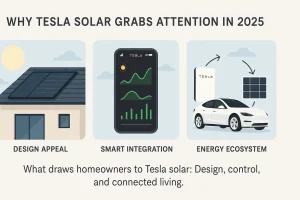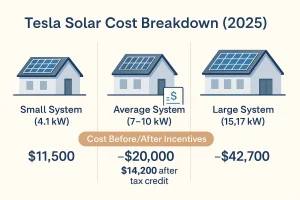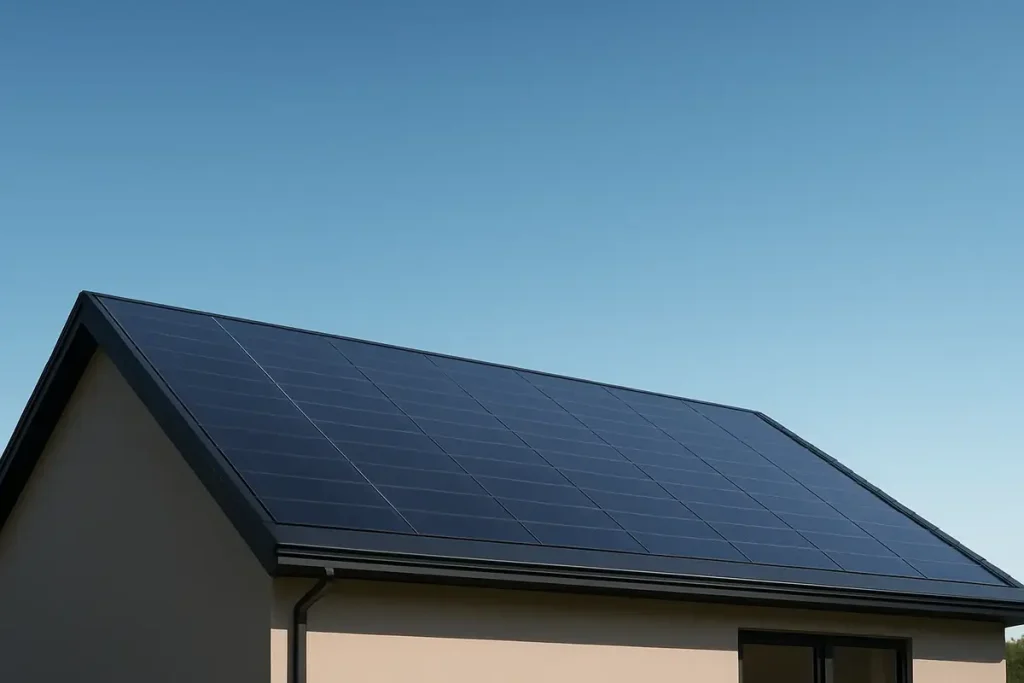Home solar energy isn’t just trending—it’s transforming how Americans power their lives. And sitting right at the crossroads of innovation and accessibility is Tesla. With its sleek, futuristic panels and promises of low-cost, clean electricity, Tesla has become the brand many homeowners automatically associate with the “smart choice.” But is it?
Beneath the ultra-modern design and confident marketing, not everyone’s experience has been sunny. Just ask Briana Greer, a homeowner in Colorado whose Tesla-installed system sparked a fire while she waited—unsuccessfully—for a service team that never showed. Her story isn’t isolated. From Arizona deserts to chilly New England towns, users are reporting system shutdowns, cryptic error messages, and months of silence from support—all while the billing meter keeps spinning.
Behind the scenes, Tesla quietly launched Project Titan—an internal fix aimed at replacing a potentially dangerous connector tied to several rooftop fires. But many customers say they were never informed, even as their systems sat idle or malfunctioned.
Still, there’s no denying Tesla’s broad appeal. In 2025, they’ve made moves into big-box stores like Home Depot, slashed pricing to as low as $2.82 per watt, and turned heads with that signature sleek black panel aesthetic. It’s tempting—and it looks smart on paper.
But here’s the question that matters: Should you actually buy Tesla solar panels in 2025? Are you getting a solid, affordable path to energy independence—or just buying into a brand story that doesn’t always deliver? Let’s see what the numbers—and the people—have to say.
Read More: Solar Power Management Systems in 2025: The Brains Behind Every High-Efficiency Rooftop
Why So Many Homeowners Are Drawn to Tesla Solar in 2025

For a lot of people, Tesla isn’t just another solar brand—it’s the solar brand. It’s the name that instantly conjures up clean lines, cutting-edge tech, and a kind of Silicon Valley confidence that says, “We’ve got this.” And to be fair, that promise is part of why so many homeowners take a serious look at Tesla first. But what exactly is behind all that buzz?
Let’s start with what you see—and what you actually get.
A Look That Doesn’t Scream “Solar Panels”
If you’ve ever seen a rooftop solar setup with clunky racks and tangled wires, you know the vibe: functional, but definitely not beautiful. Tesla flips that on its head. Their panels sit tight to the roof with no shiny frames, no clashing silver borders—just a clean, all-black design that almost disappears into the architecture.
This design-forward approach is a big deal for homeowners who care about curb appeal. And if you’re building or replacing a roof, Tesla even offers their Solar Roof—essentially energy-producing tiles that are the roof. It’s bold, it’s futuristic, and it looks incredible.
Still, looks aren’t everything. A great design can draw you in, but performance and support are what keep you happy in the long run. And that’s where things get more complicated.
The All-In-One Tesla Energy Ecosystem
Tesla’s solar system isn’t just about collecting sunshine—it’s about connecting the whole home. The panels work hand-in-hand with the Tesla Powerwall, a 13.5 kWh battery that stores energy for when the sun’s down or the power’s out. Plug in the Tesla app, and suddenly, you’re looking at a live dashboard of your home’s energy life—how much you’re using, storing, and saving.
For Tesla drivers or anyone chasing a fully electric lifestyle, this all-in-one setup is hard to ignore. Everything’s designed to work together—cleanly, smartly, and with that signature Tesla polish.
The panels themselves are made in New York’s Gigafactory 2, under a long-standing partnership with Panasonic. You can’t buy them from just any installer—they’re only sold through Tesla. That exclusivity adds to the appeal… and, sometimes, to the frustration when things don’t go as planned.
Because while the tech looks beautifully synced on paper, some homeowners say the human side—like scheduling help or getting updates—can lag far behind the machines.
More Options, More Places to Buy
Tesla’s solar lineup isn’t just panels. You can choose from the traditional rooftop panels, the Powerwall battery, or go all-in with the Solar Roof. That flexibility means it can work whether you’re upgrading an existing home or building from scratch.
And in 2025, Tesla isn’t just selling online. They’ve teamed up with Home Depot, placing staffed kiosks in hundreds of stores across the U.S. That means you can talk to a real person, check out product displays, and ask the kinds of questions a website FAQ will never fully answer.
It’s a big shift from Tesla’s early solar strategy, which tried to piggyback off its car showrooms. After the SolarCity merger didn’t quite deliver the results they hoped for, this move into big-box retail feels like a more grounded, consumer-friendly pivot.
What Does It Really Cost to Go Solar with Tesla in 2025?
When people hear “Tesla,” they often picture sleek electric cars with luxury price tags. But Tesla’s solar panels? Surprisingly, they’re one of the more affordable options out there. At roughly $2.82 per watt, Tesla’s pricing undercuts the U.S. average of $3.03—and that’s before any tax breaks or local incentives kick in.

Real Costs Depend on Where You Live—and How Much Power You Need
In solar-heavy states like California, Tesla’s estimates tend to hover close to that national baseline. But go across the country to places like New Jersey, and things start to creep up. Some homeowners there have reported quotes as high as $3.08 per watt, putting Tesla above average in that region.
And system size plays a big role, too:
- A smaller 4.1 kW system might cost around $11,500
- A larger 15.17 kW setup could come in closer to $42,700
Of course, these are pre-incentive numbers. Once you apply the 30% federal solar tax credit, things get a lot more digestible. That $20,000 average setup, for example, drops to roughly $14,200—a big difference that makes going solar with Tesla more feasible for many families.
And if you’re pairing your panels with a Tesla Powerwall, or opting for a larger system, expect to see additional discounts stacked on.
Tesla’s Solar Loan: Simpler, but Not Always Cheaper
Not everyone has tens of thousands of dollars ready to spend upfront—and Tesla knows that. That’s why they offer their own in-house financing, with no hidden dealer fees and no inflated markups. The interest rate? 7.5% APR, with 10- and 15-year options.
Now, let’s be honest—that’s not the lowest rate on the market. Other solar lenders might offer something in the 4–6% range. But here’s the tradeoff: Tesla’s loan process is cleaner. No third-party pressure, no backroom math. What you see is what you sign.
That said, experts still recommend shopping around. Convenience is nice, but if you’re financing $30,000 worth of panels, even a small rate difference can add up over time.
The $50-a-Month Solar Rental: A Great Deal… with Fine Print
Tesla shook things up a few years back by launching a solar rental program. The idea? Let homeowners dip into solar with zero upfront cost—just $50/month in select states like California, Arizona, and New Mexico.
Installation? Covered. Basic maintenance? Also covered. You get clean energy, predictable billing, and no giant check to write at the beginning.
But there’s a small catch—and it’s one that’s surprised some renters: a $1,500 removal fee if you ever decide to cancel. Tesla says they don’t profit from it, but for customers expecting a no-strings-attached experience, it can feel like an unexpected trap door.
Also, not everyone can sign up. The rental program is only available in certain states, and you have to be served by a Tesla-partnered utility.
Are Tesla Solar Panels Safe? What Real-World Incidents Tell Us
When it comes to solar energy, most people think about cutting electric bills—not calling the fire department. But for a handful of Tesla solar users, things took a much more alarming turn.
Take Briana Greer from Louisville, Colorado. Her Tesla solar system had just triggered a warning about electrical issues. Tesla scheduled a service call—for a week later. But the very next day, while Briana was out of town, her roof caught fire. Luckily, neighbors spotted the smoke and managed to stop the flames before they reached the rest of the house. The scariest part? Tesla still hasn’t explained what caused it.
No follow-up. No report. Just silence.
And her story isn’t unique. In fact, it’s part of a bigger pattern.
When Fires Made Headlines
Back in August, Walmart made national news after rooftop fires broke out at seven of its stores—each outfitted with Tesla solar systems. The retail giant responded with a lawsuit, accusing Tesla of negligence and poor system maintenance.
The main culprit? A small but critical piece of the system: the Amphenol connector. According to reports, these connectors couldn’t handle the heat passing through them, causing dangerous temperature spikes. In some cases, that led to fire.
A Quiet Fix—Without Public Warning
So, what did Tesla do about it?
Instead of sounding the alarm, the company quietly launched something called Project Titan—a behind-the-scenes campaign to replace the faulty connectors. But here’s the catch: most customers were never informed. No safety alert, no formal statement, no mass recall. For a product installed on your roof, that’s a serious omission.
While it’s important to note that these cases are rare, they do raise real concerns about Tesla’s approach to risk management—and its responsibility to homeowners.
Does Tesla Actually Deliver on Solar Performance?
Tesla has made a name for itself by promising the future—fast cars, smart tech, and now, smarter rooftops. But when you cut past the marketing and aesthetics, a fair question remains: Do Tesla solar panels actually perform as well as they claim? And more importantly, do they hold up over time?
Are Tesla Panels Powerful Enough?
Tesla’s solar panels may look like something out of a design magazine, but when it comes to raw efficiency, they’re solid—but not top-tier. Many top solar brands now push past 22% efficiency, but Tesla’s panels usually sit just below that mark.
So why the continued popularity?
Because Tesla plays the long game. Instead of maxing out each individual panel, their strategy focuses on covering more of your roof—essentially balancing slightly lower output per panel with greater total surface area. For most households, that’s more than enough to meet energy needs.
If your priority is sleek integration with the Powerwall and mobile app, Tesla still checks a lot of boxes. But if you’re a numbers-first buyer chasing the absolute best energy output per dollar, there are more efficient options on the market.
Tesla’s Solar Roof: Stunning, But Complicated
Let’s talk about the Solar Roof—Tesla’s glass-tile system that looks like it belongs in a sci-fi movie. No bulky panels. No visual clutter. Just a clean, uniform roof that secretly generates power.
It’s undeniably gorgeous. But here’s the flip side: it comes at a cost. A big one.
Estimates suggest Solar Roof installations average close to $5 per watt, which is far higher than Tesla’s traditional panels—or the industry average in general. And not all those fancy tiles are functional; only some actually generate electricity. The rest are purely decorative, which means you’re also paying for form, not just function.
Add in the need for a full roof replacement, and suddenly, you’re not just buying solar—you’re buying an entire exterior renovation. Installation timelines are longer, and only a limited number of certified crews can handle the job in many areas.
So who’s it for? Deep-pocketed homeowners who value aesthetics above all. For everyone else, standard Tesla panels remain the more practical (and wallet-friendly) choice.
The Warranty Looks Good—But What About Service?
Tesla offers a 25-year warranty on both its traditional panels and the Solar Roof. That includes promises around both energy production and physical durability. For homeowners in areas prone to high winds, Tesla also claims that their tiles can withstand up to 130 MPH gusts—a definite perk for coastal or storm-prone regions.
The panels are made with tempered glass, so they hold up better than standard shingles and don’t require as many repairs over time.
But here’s the rub: a warranty is only as useful as the company behind it. And as we’ve covered in earlier sections, Tesla’s customer service doesn’t always shine. There are real concerns about how long it takes to get a service visit—or even a call back—if something goes wrong.
So, Should You Buy Tesla Solar Panels in 2025?
Tesla solar panels definitely catch the eye. They’re stylish, fairly priced (especially compared to some competitors), and fit seamlessly into Tesla’s broader tech family. If the idea of tracking your energy use from the same app that controls your car or home battery excites you—yeah, we get it. The whole experience feels futuristic, polished, and frankly, pretty cool.
But—as with most things wrapped in sleek marketing—the truth comes down to the details. Some homeowners love their Tesla setup. Others walk away feeling let down or left hanging.
So let’s bring it home: Should you actually buy Tesla solar panels in 2025—or keep exploring your options?
When Tesla Might Be a Great Fit
If you’re already driving a Tesla or planning to add a Powerwall, choosing Tesla solar just makes sense. Everything works together under one clean system, controlled from a single app. You can check how much solar energy you’re generating, see what your battery is storing, and monitor your household usage—all from your phone, wherever you are.
Design is another area where Tesla shines. Their panels sit flush against the roof with no rails, no bulky add-ons, and none of the metallic “solar kit” look many traditional systems carry. And if you’re considering the Solar Roof, the aesthetic is even more seamless.
For homeowners in states with strong solar incentives—like California, New Jersey, or Massachusetts—the numbers can really start to work in your favor. Tesla’s average rate of $2.82 per watt is already lower than the national average. Throw in tax credits and rebates, and the overall cost becomes a lot more manageable.
Tesla also keeps financing simple. Their in-house loan offers 7.5% APR, with no dealer fees or confusing markups. It’s not the rock-bottom rate, but it’s straightforward—and sometimes, a clear process is worth more than a few points shaved off the interest.
When Tesla Might Not Be Right for You
That said, Tesla isn’t for everyone—and it’s better to know that before you sign.
If you’re someone who values prompt, responsive customer service—especially when something goes wrong—Tesla might test your patience. Many users have shared stories of delayed responses, missed service windows, or feeling like they were left to figure things out on their own. And when your roof is part of the equation, waiting weeks for an answer doesn’t exactly inspire confidence.
Availability is another real limitation. Tesla doesn’t have installation teams everywhere. In some areas, you might face long wait times—or find out Tesla won’t install at all. You can work with a third-party contractor, but that may mean giving up direct access to Tesla pricing or warranty support.
And if you’re someone who likes full transparency—clear service logs, open communication, or a tech who walks you through every step—Tesla’s quiet, sometimes hands-off approach might leave you frustrated. The tech is smart. The support, not always.
FAQs
1. How much do Tesla solar panels cost?
On average, Tesla quotes hover around $2.82 per watt—a bit below the U.S. average of about $3.00 per watt.. For most homes, that translates to $11,000–$42,000 up front, depending on system size. But here’s the kicker: after the 30% federal tax credit, your actual cost drops significantly—and Tesla doesn’t sneak in extra dealer fees, so what you see is truly what you pay.
2. Are Tesla solar panels worth it?
They’re eye-catching, well-priced compared to big solar brand rates, and beautifully tie into Tesla’s ecosystem—especially for Powerwall owners. But “worth it” depends on what matters to you. If you care most about design, clean tech, and slick brand integration—Tesla’s a strong candidate. Just expect that customer service isn’t always flawless, according to some user reports.
3. Where are Tesla solar panels made?
Tesla makes its panels at Gigafactory 2 in Buffalo, NY, in partnership with Panasonic . That means you’re supporting local manufacturing—no overseas delays, and plenty of U.S.-based jobs.
4. How long do Tesla solar panels last?
Tesla offers a 25-year warranty, and many panels outlast that timeline—even as their efficiency slowly declines. Think of it as a long-haul investment that keeps paying out—just like any good solar setup.
5. How do you clean Tesla solar panels?
Most of the time you don’t have to. Rain does the cleaning for you. But if you’re in a dusty area or have leaves falling all over, a gentle hose rinse a few times a year should do. And if heights aren’t your thing, hiring pros is a smart (and safer) move.
6. Can you buy a Tesla Powerwall without solar panels?
Absolutely. You can get a Powerwall by itself—no panels required. It’s perfect if you just want backup during outages or take advantage of time-of-use rates. Pairing with solar makes it ideal—but it can stand on its own.
7. How do you transfer Tesla solar panel ownership?
If you are selling your home than Tesla allows you to transfer the solar agreement to the new owners through a bit of paperwork. They’ll guide both parties—and having solar already in place can actually boost your home’s appeal.




